While functional mushrooms have been used for millennia, it's only in recent years that they’ve truly come into the spotlight, as the western world catches on to just how beneficial they can be.
But as the adaptogenic mushroom industry grows, so does the need to look closer at how these mushrooms are grown and produced. Do you know where your mushrooms come from? Are they grown ethically and sustainably? Are they free from heavy metals and toxins? And even more importantly – are they as healthy as the marketing claims?
As with plants, it starts with the seed – or in this case, spores. In this article, we’ll go through each stage of functional mushroom production, from planting to harvest, and teach you how to spot mushroom supplements that are ethical, sustainable, and non-toxic. Let’s get into it.
Mushrooms Absorb Their Growing Environments
Firstly, let’s take a look at how functional mushrooms grow. There are thousands of different species, but most functional mushrooms grow on so-called substrates, which is a host organism that they form a symbiotic or parasitic relationship with. Oftentimes, these are trees or other plants.

Because mushrooms are bio-accumulators, they have the ability to absorb and concentrate compounds in their surrounding environment. As they grow, they consume part of the nutrients that feed their substrate, and by doing so, absorb and transform them. While this includes beneficial compounds, they can just as easily absorb toxins, pollutants, and heavy metals.
In other words, if a mushroom is grown in a polluted environment, it will naturally absorb those toxins. This is why it's so important to know where and how your functional mushrooms are grown.
Wild vs Cultivated Functional Mushrooms
Functional mushrooms are either harvested from their wild environments, or cultivated in mushroom farms. Both of these growing methods come with their own benefits, so let’s look closer at both.
Wild-Harvested Functional Mushrooms

Mushrooms naturally grow in the wild, and studies have found that adaptogenic mushrooms harvested from their natural environments are the most nutritious. This is partly because the nutrition formed in the mushroom is related to their food source, namely the substrate organism they grow on.
When adaptogenic mushrooms grow on trees that provide more of a “challenge” for the mushroom, they form more powerful antioxidants in response. Certain nutrients are also a direct result of the compounds locked inside the tree itself – if grown on a different substrate, the mushroom may not form those nutrients at all (though, they may form others instead).
However, it’s no secret that we live in an increasingly polluted world, where tons of chemicals and waste get dumped into nature each day. On top of these man-made toxins that seep into the soil, water, and air, certain heavy metals also accumulate in natural environments.

Because of this, mushrooms grown in the wild have a higher chance of containing heavy metals and other polluted toxins – studies have found that wild-harvested functional mushrooms may contain concentrations of mercury, lead, arsenic and cadmium, depending on where they’re grown. These heavy metals are known to be toxic to the human body, and enough exposure can cause serious, long-term damage.
Cultivated Functional Mushrooms
While adaptogenic mushrooms farmed in controlled environments may not have as powerful a nutritional profile as wild-harvested fungi, they are still rich in powerful antioxidants and beta-glucans – and generally safer to eat.
In cultivated mushroom farms, the surrounding environment is optimized and regulated to ensure that no pollutants or toxins seep into the mushroom. The controlled environment also makes cultivated mushroom farms typically more transparent, which makes it easier for you to trace the entire production chain and its ethics.
Wild Harvested Functional Mushrooms Are Less Sustainable
Sustainability is another consideration when choosing between wild and farmed adaptogenic mushrooms. With the interest and demand for functional mushrooms on the rise (consumption has increased x30 since the 1970s and continues to grow) more and more people are over-harvesting the adaptogenic mushrooms growing in nature.

Functional mushrooms need specific conditions to thrive, a combination of the right host, humidity, light, and temperature. This makes them rare to find in nature. They are also typically slow-growing organisms, and can take years before they’re ready to harvest – chaga, for example, takes on average 20 years to fully mature on a birch tree.
The most sustainable way to harvest these mushrooms is to leave part of the mushroom behind, so that it can regrow quicker. Harvesting all of it could also do damage to the host plant, leaving it vulnerable and exposed where the mushroom used to sit. But since demand far outweighs the supply nature has to offer, wild-harvested functional mushrooms rarely take this into account.
In short, wild functional mushrooms are virtually impossible to sustainably harvest at the scale needed today, which poses a threat to the environment and future mushroom populations.
Meanwhile, farmed functional mushrooms are quicker to grow and able to follow ethical and sustainable harvesting practices. They also support the wild mushroom populations and the eco-systems they’re part of, by not depleting nature’s supplies.
Importance of Organic Functional Mushrooms
Just like mushrooms absorb pollutants from their environment, they also absorb pesticides and fertilizers used in conventional farming. Pesticides have a negative impact on human health – among other things, it can cause skin and eye irritation, allergies, and reproductive issues by disrupting hormone levels in the body.
Pesticides and fertilizers also have a disruptive effect on the environment and pose a serious threat to the future of farming and food security. Pesticides lower soil quality and leaks into waterways, causing pollution to our already vulnerable planet. Even worse, over time pesticides lower the density of nutrition in plants.

In other words, choosing organically farmed functional mushrooms not only ensures a mushroom clean from toxins, but also a more ethical and sustainable production chain from start to finish. This is the number one way to ensure your adaptogenic mushroom supplier isn’t harming the planet.
Food Safety Regulations Differ Between Countries
Which part of the world the adaptogenic mushrooms are sourced from can also impact the quality and safety of the final supplement. This mainly has to do with two things: the local regulations around food safety and production, and mycotoxins.
Where Is the Functional Mushroom Grown?
Most functional mushrooms today are grown and cultivated in China, which provides a baffling 85% of the global supply of functional mushrooms. Adaptogenic mushrooms have a long-standing history in China, since they play a central role in Traditional Chinese Medicine, and cultivation dates back centuries. Because of this, China can provide functional mushrooms at a high volume and lower cost than many other parts of the world, and currently dominate the global market.
While there are ethical and quality mushroom suppliers in China, the national regulations around food safety and production are low compared to those in the EU and the US. This makes the production chain less transparent and traceable, and the testing for toxins less rigorous. This may increase the risk of toxins and heavy metals in the adaptogenic mushrooms.

U.S. Grown Functional Mushrooms
By choosing functional mushrooms cultivated in the U.S., you can be certain that the quality of the mushroom holds up to the U.S. agricultural standards, where demands on soil quality, water safety, and non-toxic food products are high.
Mycotoxins in Functional Mushrooms
Mycotoxins are the toxic compounds that form from mold, and while this is not generally associated as a huge issue for functional mushrooms, ingredients only known for their “mycobenefits”, long transportation routeas increase the risk of any food product developing mold. This is because transportation of food often involves tightly packed spaces and humidity, which creates an ideal breeding ground for mold spores.
In addition to the environmental impact of food transported across the world, the further away the functional mushroom was cultivated, the higher the chances that mycotoxins have formed during transportation. With this in mind, choosing mushrooms sourced closer to home, and that have been tested for mycotoxins alongside heavy metals and other pollutants, is a healthier choice.
Want to learn more about mycotoxins? Check out our full breakdown here.
What to Look for in Functional Mushroom Supplements
If you’re looking for functional mushrooms that have been ethically produced and are safe for consumption, here’s a handy checklist before you buy:
Sustainably Cultivated: Wild-harvested functional mushrooms may contain heavy metals and other pollutants absorbed from their environment. There is also risk of overharvesting which damages the surrounding ecology, posing a risk to the environment and mushroom populations.
Adaptogenic mushrooms sustainably cultivated on oats or brown rice are generally safer to consume and more ethically produced.

Organically Farmed: Functional mushrooms may absorb pesticides and fertilizers used in conventional farming. These farming practices also pose a threat to the environment by damaging soil quality, polluting waterways and more.
Choosing certified organic adaptogenic mushrooms is one of the best ways to ensure they are of high quality, and produced with minimal environmental impact.
U.S. Grown: Depending on the country, regulations for food safety and farming practices differ drastically. The U.S. and EU have the most rigorous systems for controlling the quality of food and ensuring a sustainable production chain. Long transportation of mushrooms also increases the risk of mycotoxins and mold.
Adaptogenic mushrooms grown locally in the U.S. are guaranteed to reach the U.S. food safety and production standards. They also minimize the environmental impact of long transports and the risk of mycotoxins.

Rigorously Tested: Functional mushroom suppliers who are serious about the health benefits and efficiency of their products should always test their batches for heavy metals, mycotoxins, as well as beta-glucans, and be happy to share those results. Transparency is key to knowing how your mushroom supplements are sourced, and ensuring that the final product is high quality, safe, and efficient.
Adaptogenic mushroom suppliers should test their products for toxins and efficiency, and information about their production chain should be readily available to the consumer.
Peak State: High-Quality, Organic, US Grown & Tested Mushroom Coffee
If you’re looking for functional mushroom supplements that are ethically produced and safe for consumption, look no further than Peak State’s premium mushroom coffees, created with your health and the planet in mind.
All of our functional mushrooms are organic and Fairtrade certified, sustainably cultivated on brown rice right here in the U.S. Double-extracted with 500mg per serving, each batch is also rigorously third-party tested for heavy metals, mold and mycotoxins, and are 100% clean.

Combined with antioxidant-rich, organic coffee beans, mushroom coffee is a great way to get all the benefits of functional mushrooms in your daily cup of joe. Curious to give it a try? Get a free sample of your preferred roast delivered right to your front door today!
New to mushroom coffee? Read all about the benefits of functional mushrooms in your daily java here.
Bottomline: Ethical & Safe Functional Mushroom Sourcing
There are multiple things to look for in a high-quality, safe, and ethically sourced adaptogenic mushroom product.
Choosing cultivated mushrooms over wild mushrooms lowers the risk of heavy metals and toxins, and avoids unsustainable over-harvesting. It also typically provides both mycelium and fruiting body extracts, which comes with additional health benefits.

Choosing certified organic makes for a product clean of toxic pesticides, and is the kindest choice for the planet.
Choosing adaptogenic mushrooms grown locally in the U.S. ensures ethical and rigorously controlled farming practices, and reduces the chance of mycotoxins formed during long transportations.
Finally, choose products that have transparency around their production chain and that test for heavy metals, mycotoxins, and other pollutants, to ensure your functional mushroom product is clean, ethical, and safe to consume.
Psst…. Look out for the next part of this article, where we’ll break down how to make sure your mushroom product gives a real health-boosting effect!

